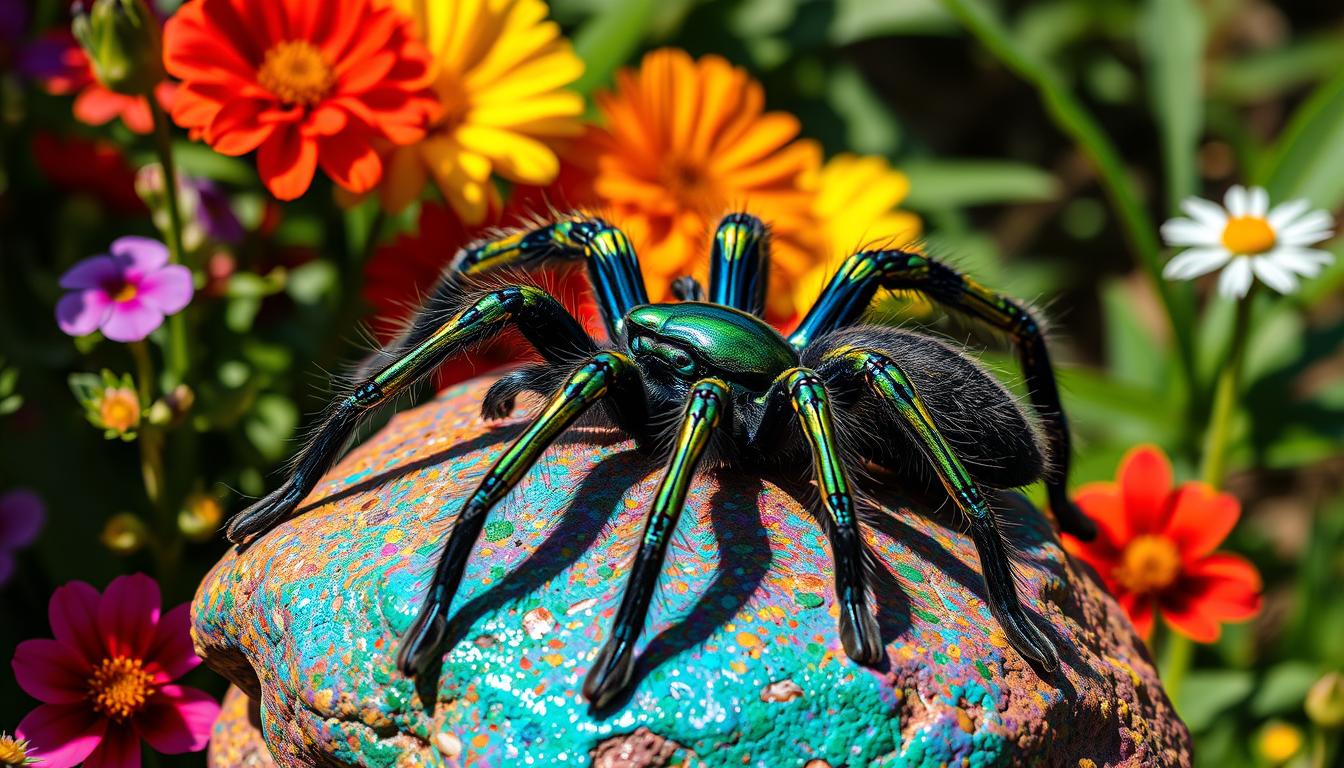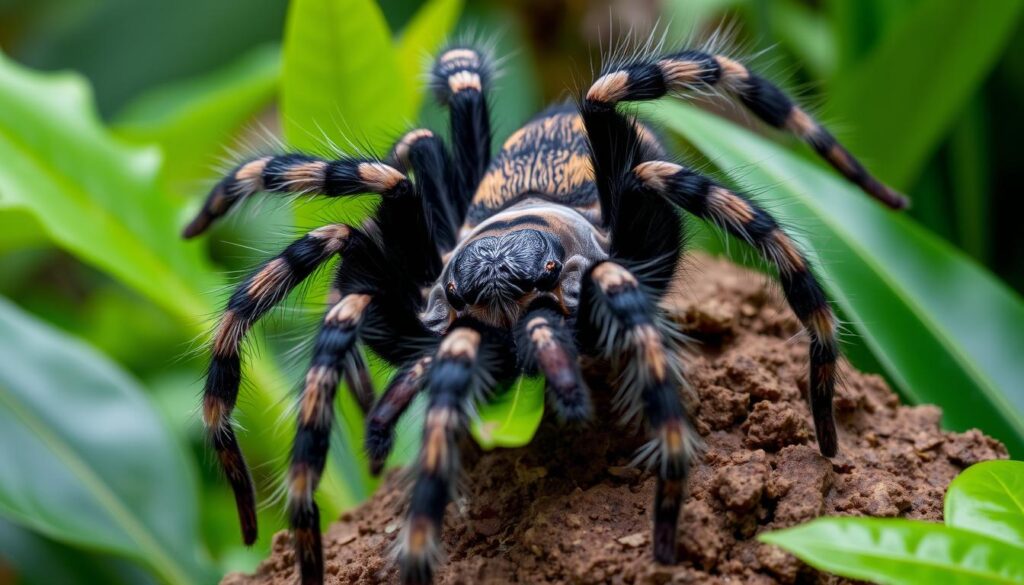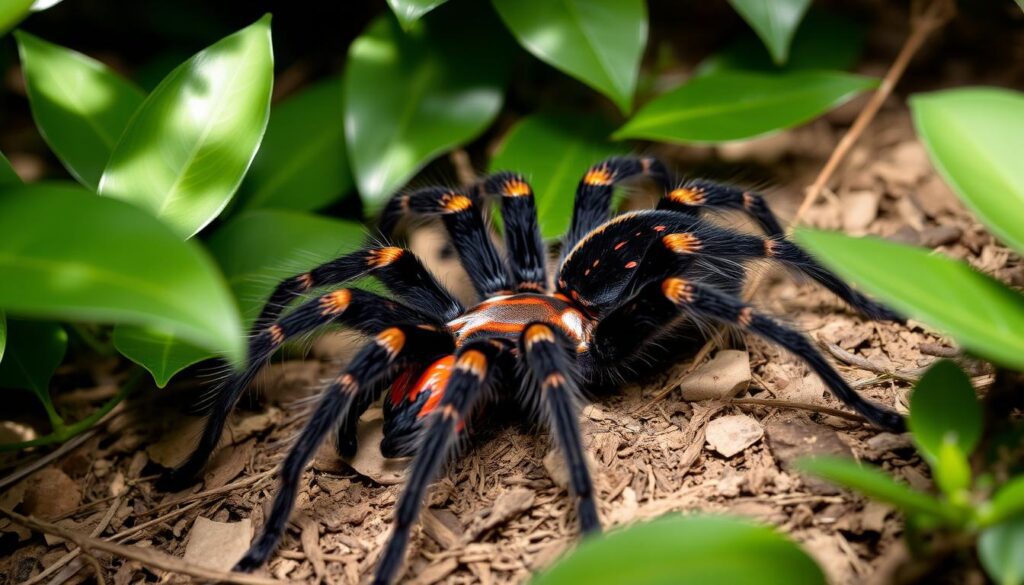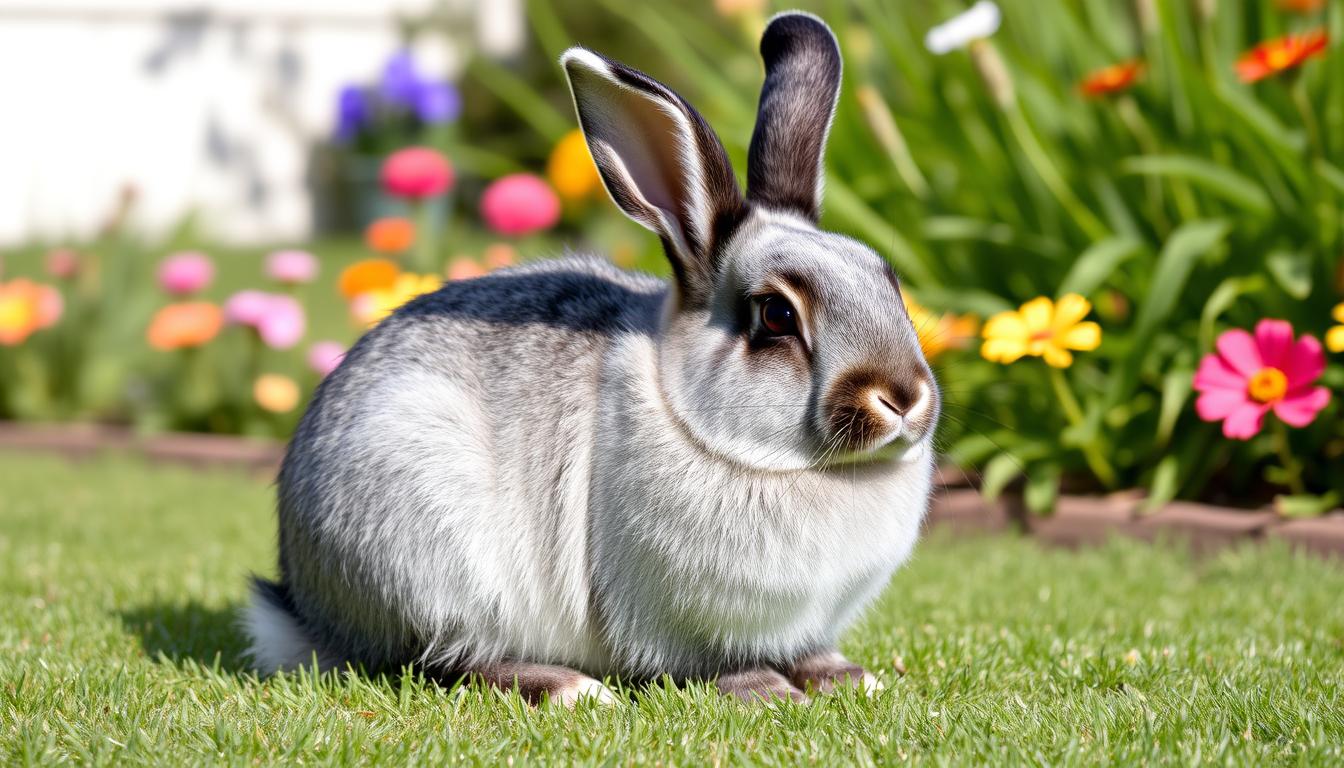Metallica Tarantula: Exploring the Captivating Spider

The metallica tarantula is from India and is known for its bright blue color. It’s considered one of the most stunning and rare tarantulas globally. It lives in a small area of about 39 square miles in Andhra Pradesh, India1. You can find more about the metallica tarantula and its conservation status at metallica tarantula facts online. Males live for 3-4 years, while females can live up to 11-12 years2.
Key Takeaways
- The metallica tarantula is a rare and beautiful species native to India.
- It has a limited natural habitat of approximately 39 square miles in Andhra Pradesh, India1.
- The metallica tarantula has a lifespan of 3-4 years for males and 11-12 years for females2.
- It is considered one of the most sought-after species in the world due to its vibrant blue coloration.
- Conservation efforts are crucial due to threats from habitat destruction and potential exploitation in the pet trade1.
- The metallica tarantula is a popular pet choice, but its care requires specific attention to its diet, habitat, and health2.
Introduction to the Metallica Tarantula Species
The metallica tarantula, also known as Poecilotheria metallica, belongs to the Theraphosidae family3. It is found in the wild in Andhra Pradesh and Tamil Nadu, India. This species is known for its bright colors and unique traits, making it a favorite among tarantula fans.
Female metallica tarantulas grow to show off vibrant blues, whites, and yellows3. Males are smaller and less colorful, without the tibial hooks/spurs found in females3. They prefer living in tree bark, holes, and crevices, needing vertical structures and deep substrate for burrowing3.
Here are some key facts about the metallica tarantula species:
- Scientific Name: Poecilotheria metallica3
- Common Names: Sapphire Ornamental, Gooty Sapphire Ornamental3
- Occurrence rate: One of the most sought-after species for almost every tarantula hobbyist3
- Temperament: Considered to have the best temperament among the Poecilotheria genus, known to hunker down or run rather than show aggression3
The metallica tarantula is rare in captivity due to breeding challenges, making it pricey4. Captive breeding can produce about 150 young4. With the right care and habitat, it can be a rewarding pet for tarantula experts.
| Characteristic | Description |
|---|---|
| Scientific Name | Poecilotheria metallica3 |
| Common Names | Sapphire Ornamental, Gooty Sapphire Ornamental3 |
| Occurrence rate | One of the most sought-after species for almost every tarantula hobbyist3 |
Physical Characteristics and Appearance
The metallica tarantula is known for its size, with a body length of about 4-6 inches5. Its bright blue color and yellow and white patterns on its belly make it stand out6. These features make it a beautiful species among tarantulas.
It’s important to remember that the size and color of a metallica tarantula can vary5. But, its unique look is what makes it so popular among tarantula fans.
If you’re interested in exotic pets like the metallica tarantula, check out petpawza. They have lots of info on different species and how to care for them.
The metallica tarantula’s look is not only eye-catching but also unique in the tarantula world6. It’s also known for growing fast, with some growing about 0.5 inches with each molt6.
- Body length: approximately 4-6 inches5
- Distinctive pattern of yellow and white markings on its abdomen
- Vibrant blue coloration6
- Rapid growth, with some individuals growing approximately 0.5 inches with each molt6
The Natural Habitat of Metallica Tarantula
The metallica tarantula lives in a unique environment. It is found in the Indian states of Andhra Pradesh and Tamil Nadu7. In the wild, it builds complex burrows using its legs and sharp claws8.
The environment is warm and humid. It has a temperature of 75-85°F and humidity of 60-80%8.
This tarantula’s home is small, covering less than 100 square kilometers. It is rare and endangered8. Logging and firewood harvesting harm its habitat. Conservation is key to save this species.
Environmental Conditions
The metallica tarantula thrives in warm, humid places. It likes temperatures between 75-85°F and humidity of 60-80%8. High rainfall helps keep its habitat humid and warm7.
Burrow Construction
The metallica tarantula is great at building burrows. It uses its legs and claws to dig complex ones8. These burrows protect it from predators and are crucial to its habitat7.
The tarantula digs burrows in areas with loose soil and plants. This makes it easier for it to build its homes.
| Characteristics | Description |
|---|---|
| Temperature | 75-85°F |
| Humidity | 60-80% |
| Geographic Distribution | Andhra Pradesh and Tamil Nadu, India |
Essential Care Requirements
For metallica tarantula care, the right environment is key. The housing needs to be well-ventilated and secure. It should have a temperature of 75-85°F and humidity of 60-80%9. This setup will make a comfy space for your tarantula.
Choosing the right substrate is important. Use a deep, clean substrate like peat moss or coconut fiber. It lets the tarantula burrow and keeps humidity up10. Keeping it clean and dry is crucial to avoid bacteria and fungi.
Housing Setup
A good enclosure for a metallica tarantula is vertically-oriented. It needs good ventilation to avoid moisture buildup. A 10-gallon aquarium stood on end with a custom front for ventilation is perfect9.
Temperature and Humidity
Keeping the right temperature and humidity is crucial. The temperature should be 75-85°F, and humidity 60-80%10. Use a hygrometer for humidity and a thermometer for temperature.
Substrate Requirements
The substrate should be deep for burrowing and kept clean and dry. Peat moss or coconut fiber is a good choice. Replace it often to avoid bacteria and fungi9.
| Substrate Type | Depth | Humidity Level |
|---|---|---|
| Peat Moss | 4-6 inches | 60-80% |
| Coconut Fiber | 4-6 inches | 60-80% |
By following these guidelines, you can create a great environment for your metallica tarantula. This ensures it gets the best care and thrives in its new home.
Feeding Your Metallica Tarantula
Feeding your metallica tarantula right is key. You need to give them a mix of insects like crickets, mealworms, and waxworms. Knowing what your tarantula needs is important for their health11.
These tarantulas hunt in the wild, using their legs and claws. In your home, you should make their environment exciting and challenging5.
Here are some tips for feeding your metallica tarantula:
- Give them a variety of insects, like crickets, mealworms, and waxworms12
- Learn what your tarantula needs to eat5
- Make their home like their natural habitat11
By following these tips, you can make sure your tarantula is happy and healthy12. Always do your research and talk to a vet or tarantula expert if you’re unsure5.
| Food Item | Frequency | Portion Size |
|---|---|---|
| Crickets | 2-3 times a week | 2-3 crickets per feeding |
| Mealworms | 1-2 times a week | 1-2 mealworms per feeding |
| Waxworms | 1 time a week | 1 waxworm per feeding |
Behavior and Temperament

Metallica tarantulas are calm and docile, making them perfect for hobbyists3. But, they can move fast, so you must be careful to prevent escape3. They are known for their calm nature, unlike some other tarantulas3.
These tarantulas like to be alone and are active at night13. They hunt using their strong legs and sharp claws3. Giving them vertical spaces helps them climb and spin webs naturally3.
Defense Mechanisms
Metallica tarantulas use their legs and sharp claws for defense3. They can also release urticating hairs3. They eat well and grow fast, which is good for hobbyists3.
For more info on tarantula care, check out this website13. Knowing about their behavior helps you care for them better3.
Mating Behavior
Metallica tarantulas have unique mating habits13. Males live 3-4 years, while females can live up to 12 years13. They need 75 to 80% humidity to survive13.
| Metallica Tarantula | Behavior | Temperament |
|---|---|---|
| Solitary | Nocturnal | Calm and docile |
| Skilled hunter | Powerful legs and sharp claws | Tendency to hunker down or run |
Health and Lifespan Expectations
Understanding the metallica tarantula lifespan is key. These spiders can live up to 10-15 years in captivity. Some have even reached 20 years6. This means they are a long-term friend, needing your dedication to their care.
Regular vet visits and a good diet are essential for their health. This helps keep your tarantula in top shape.
Watch out for health problems like respiratory infections and parasites. If your tarantula seems sick or stressed, get vet help fast. For more on tarantula care, check out scientific research articles. Or, learn about other pets like the Bernese Mountain Dog on petpawza.
Here are some important health and lifespan tips for your metallica tarantula:
- Keep their environment right, with the right temperature and humidity.
- Feed them well, with a mix of foods and a regular schedule.
- Make sure they have fresh water and a clean home.
By following these tips and staying up-to-date on your tarantula’s needs, you can help them live a long, happy life6.
Breeding and Reproduction Cycles

Metallica tarantula breeding is a delicate process. It needs careful attention to the tarantula’s behavior and its environment14. In the spring, the female mates with the male. The male then deposits his sperm into the female’s epigyne. This is key for successful reproduction15.
The female lays her egg sac, which can hold up to 100 eggs. The eggs hatch after 6-8 weeks15. The spiderlings start their lives and go through molts as they grow. It’s important to give them the right environment and care8.
Mating Process
The male deposits his sperm into the female’s epigyne in a complex process14. The female stores the sperm. She uses it to fertilize her eggs when she’s ready to lay her egg sac.
Egg Sac Care
After the female lays her egg sac, it’s vital to provide the right conditions for the eggs and spiderlings to develop15. This includes the right temperature, humidity, and food and water.
Spiderling Development
The spiderlings molt as they grow and develop8. It’s crucial to give them the right conditions to thrive. With proper care, they grow into healthy adult tarantulas, ready to breed again.
| Species | Distribution | Lifespan |
|---|---|---|
| Poecilotheria metallica | India | Female: up to 12 years, Male: significantly shorter |
Common Challenges and Solutions
As a Metallica Tarantula owner, you might face some challenges. These include finding the right environment and diet for your pet16. Knowing these challenges and how to solve them is key. A balanced diet and a proper environment are crucial. This means keeping the temperature between 75-85°F and the humidity at 60-80%16.
Some common problems include respiratory infections and parasites16. To avoid these, watch your tarantula closely. If you see signs of illness or stress, get vet help right away16. Also, make sure the enclosure has good air flow to prevent humidity problems16.
Here are some solutions to common challenges:
- Provide a balanced diet that includes a variety of food items16
- Keep the enclosure clean and well-ventilated16
- Monitor your tarantula’s health and behavior closely16
- Seek veterinary attention if you notice any signs of illness or stress16
By knowing these challenges and how to solve them, you can give your tarantula a happy life16. Always do your research and ask experts if you have questions or concerns1718.
| Challenge | Solution |
|---|---|
| Respiratory infections | Provide a clean and well-ventilated enclosure |
| Parasites | Keep the enclosure clean and provide a balanced diet |
Conclusion: Is a Metallica Tarantula Right for You?
TheMetallica Tarantulaused to be a top pick for tarantula fans19. But, newer and rarer species have become more popular20. With over 900 tarantula species20, what you like will decide if the Metallica Tarantula is for you.
If you’re ready to care for this tarantula, it can be a great pet. You’ll need to know its housing, temperature, humidity, and feeding needs19. With the right care, you’ll enjoy its beauty and behavior.
Choosing a Metallica Tarantula is a personal choice. As you explore tarantulas, stay open to new species and trends. Finding the perfect tarantula is part of the fun of being a fan1920.
FAQ
What is the scientific classification of the Metallica Tarantula?
Where is the natural distribution of the Metallica Tarantula?
What are the physical characteristics of the Metallica Tarantula?
What are the environmental conditions required for the Metallica Tarantula?
What kind of housing and substrate is recommended for the Metallica Tarantula?
What does the Metallica Tarantula eat?
What is the temperament and behavior of the Metallica Tarantula?
How long can the Metallica Tarantula live?
How does the Metallica Tarantula breed and reproduce?
What are some common challenges and solutions when caring for a Metallica Tarantula?
Source Links
- https://animals.howstuffworks.com/endangered-species/peacock-tarantula.htm – Nobody Knows Why the Peacock Tarantula Is Blue
- https://bantam.earth/gooty-sapphire-tarantula-poecilotheria-metallica/ – Poecilotheria Metallica: Gooty Sapphire Tarantula Care Guide
- https://www.mymonsters.co.za/product/poecilotheria-metallica/ – Poecilotheria metallica-Sapphire Ornamental | My Monsters
- https://www.giantspiders.com/species/poecilotheria-spp/ – giantspiders.com – Poecilotheria spp.
- https://www.thetarantulacollective.com/caresheets/poecilotheria-metallica – Gooty Sapphire Ornamental Tarantula (Poecilotheria metallica) Care — The Tarantula Collective
- https://tomsbigspiders.com/2014/05/24/yes-tarantulas-can-be-beautiful-p-metallica/ – The Poecilotheria metallica – Yes, Tarantulas Can Be Beautiful
- https://recentlyextinctspecies.com/chelicerata/poecilotheria-metallica – Poecilotheria metallica (Peacock tarantula, Peacock parachute spider, Metallic tarantula, Gooty tarantula)
- https://en.wikipedia.org/wiki/Poecilotheria_metallica – Poecilotheria metallica
- https://www.nwzoo.com/pdf/NWZoo_Gooty_Sapphire_Ornamental_Care.pdf – PDF
- https://www.thetarantulacollective.com/caresheets/poecilotheria-ornata – Fringed Ornamental Tarantula (Poecilotheria ornata) care — The Tarantula Collective
- https://arachnoboards.com/threads/best-way-to-feed-p-mattalica-juveniles.322678/ – Best way to feed P.mattalica juveniles
- https://marshallarachnids.com/pages/poecilotheria-metallica-care-guide?srsltid=AfmBOoo5czw8tMN_vAOwxA6meBiCvK8zSspxtMQroRApILsF40B7WprR – Poecilotheria metallica care guide
- https://www.tarantulaheaven.com/beginners-guide-to-gooty-sapphire-ornamental-poecilotheria-metallica/ – Beginner’s Guide To Gooty Sapphire Ornamental (Poecilotheria metallica)
- https://fearnottarantulas.com/pages/tarantula-breeding-projects?srsltid=AfmBOorkth_JtUO3MHViq-TI-8I-dBsSkv3pvYSRMPrbG6eurl5mOGvB – Tarantula Breeding Projects
- https://tarantulafriendly.com/gooty-sapphire-ornamental-poecilotheria-metallica/ – Gooty Sapphire Ornamental – Poecilotheria metallica – Tarantula Friendly
- https://arachnoboards.com/threads/help-sick-p-metallica.306666/ – Help!!!!! Sick p Metallica
- https://www.federalregister.gov/documents/2018/07/31/2018-16359/endangered-and-threatened-wildlife-and-plants-endangered-species-status-for-five-poecilotheria – Endangered and Threatened Wildlife and Plants; Endangered Species Status for Five Poecilotheria Tarantula Species From Sri Lanka
- https://tomsbigspiders.com/2018/08/10/the-u-s-fish-and-wildlife-service-ruling-on-sri-lankan-poecilotheria-species/ – The U.S. Fish and Wildlife Service Ruling on Sri Lankan Poecilotheria Species.
- https://davethebugguy.org/2015/09/12/rehousing-tarantulas-poecilotheria-metallica/ – REHOUSING TARANTULAS: Poecilotheria metallica
- https://bantam.earth/beginner-pet-tarantula-types/ – 24 Pet Tarantula Types For Beginners + Care & Setup Guides



